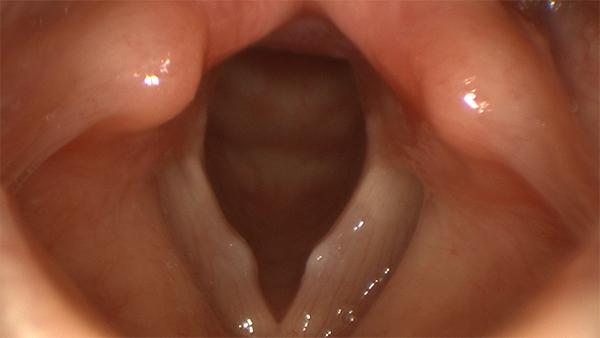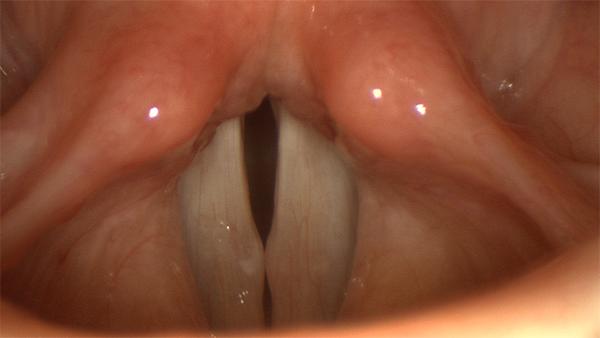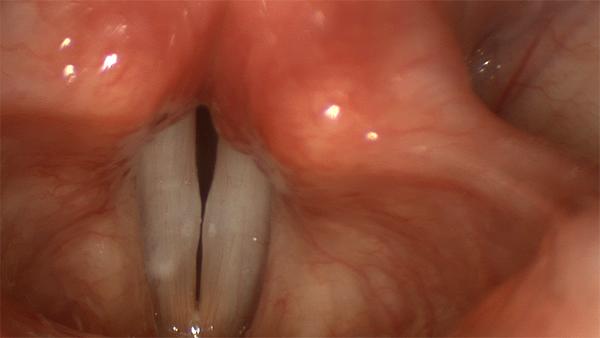What are nodules?
Nodules are symmetric, broad-based masses (“mass” simply means “lump”, and does not imply cancer) which occur at the midpoint of both vocal folds. This location suggests that nodules are the result of phonotrauma, the physical stresses on the vocal fold occurring with heavy voice use or voice use under adverse circumstances. Nodules are found almost exclusively in young women and pre-adolescent boys, which suggests that the size and shape of the larynx is an important factor in nodule formation. Nodules are a well known problem of professional and amateur musical theater singers. Some have hypothesized that it is due to the particular style of singing prevalent in musical theater, and others have proposed that it is simply related to the increased amount of voice use or the intensity of the performance schedule.

Nodules are symmetric lesions of the mid-portion of the vocal fold.
Nodules in Men
Bilateral vocal fold lesions in adult men are almost never nodules. Any adult male should be examined very carefully before settling on a diagnosis of nodules. Stroboscopy is very helpful in clarifying the diagnosis in most cases.
Nodules are not precancerous or cancerous lesions. In general, the symmetric bilateral nature of nodules, and the fact that they occur in younger people is enough to remove any doubts about malignancy and make a biopsy unnecessary.
The term “nodules” is sometimes used in a general sense to refer to any mass of the vocal folds, even by otolaryngologists. In addition to being imprecise, this can lead to confusion and errors in treatment and should be avoided.
What are the symptoms of nodules?
Nodules generally cause painless hoarseness. The hoarseness results from irregularities not only in vocal fold closure, but also in vibration characteristics - both the result of the bulk of the nodules. The hoarseness of nodules typically worsens with voice use, or during a cold or sore throat, and improves with voice rest. People with vocal fold nodules typically find their voice worse after cheering at a game, an evening out with friends, or a strenuous vocal performance.

Nodules impair voice by interfering with effective vocal fold closure and vibration during voicing.
What do nodules look like?
Nodules are symmetric or nearly symmetric mid-vocal fold masses. They may vary in size from patient to patient. They are broad-based, and resemble a mound of tissue that stands out from the edge of the fold. Nodules are the same color as the rest of the vocal fold, in contrast to many polyps, which are usually red. Nodules do not grow dramatically over the short-term, although they may swell with repeated trauma from voice use.
Unilateral Vocal Fold Mass
A unilateral vocal fold mass is not a nodule by definition. Nodules always occur in pairs and are of approximately equal size. Paired masses that are not symmetric should be examined very carefully before settling on a diagnosis of nodules. They will usually be found to represent a cyst or a polyp with some thickening from impact damage on the opposite vocal fold.

Nodules always occur in pairs.
How are nodules treated?
Voice rest, often prescribed in cases of hoarseness, may improve the voice somewhat and even help to shrink nodules, but is not likely to make them go away. Voice rest serves to reverse swelling associated with phonotrauma and can help restore baseline voice, but hoarseness will recur the next time the voice is used strenuously unless underlying patterns of voice use change. Similarly, anti-inflammatory medications such as steroids are often used to reduce swelling, but do not address the root problem.
Voice therapy is the mainstay of initial treatment for nodules. The goal is to make the person aware of circumstances and habits of voice use that have led to the problem, and to find strategies of voice use that will be less troublesome. It is important to understand that even excellent voice therapy and a determined patient usually do not make nodules disappear, because nodules appear to be partly a product of other factors like anatomy. Voice therapy will merely make nodules softer and more flexible and thereby improve the voice.
Misconceptions about nodules abound, particularly in the performing arts community. Because nodules result from many factors, some beyond our ability to change, they represent a condition that needs to be managed over time, rather than “fixed” once and for all. Also, nodules are not a “career ender” for the professional vocalist. With discipline and good judgment, nodules need not impair a performing arts career.
Occasionally, microlaryngoscopic surgery is considered in the management of nodules. In many cases, surgery alone is generally not useful, as nodules will reform in response to factors that surgery cannot alter. Sometimes however, nodules are so well formed, as a result of long-standing and repeated phonatory damage, that no amount of voice therapy can improve the voice. In such cases, microlaryngoscopic surgery may be used to remove the tangle of hardened tissue that has accumulated. A thorough examination, under anesthesia in the operating room, is also useful to resolve any confusion regarding the presence of a cyst or a polyp. In almost all cases, a trial of voice therapy prior to surgery is a good idea, and the risks of surgical scar should be weighed carefully against the current level of vocal disability, the certainty of the diagnosis, and the likely benefits of the procedure.

